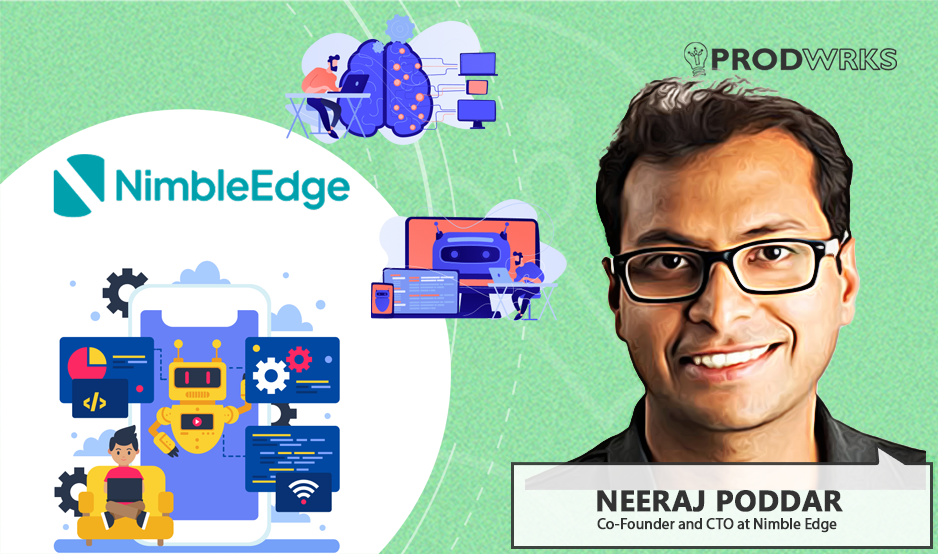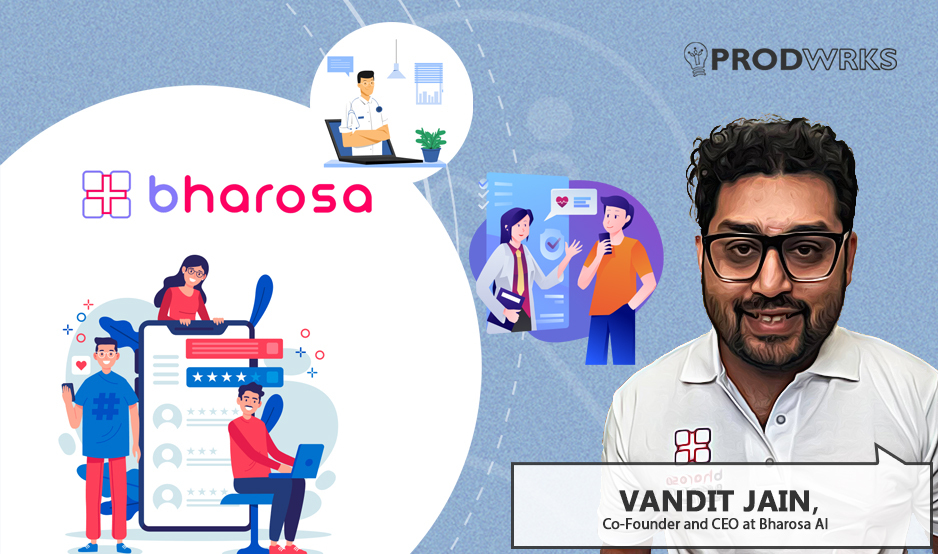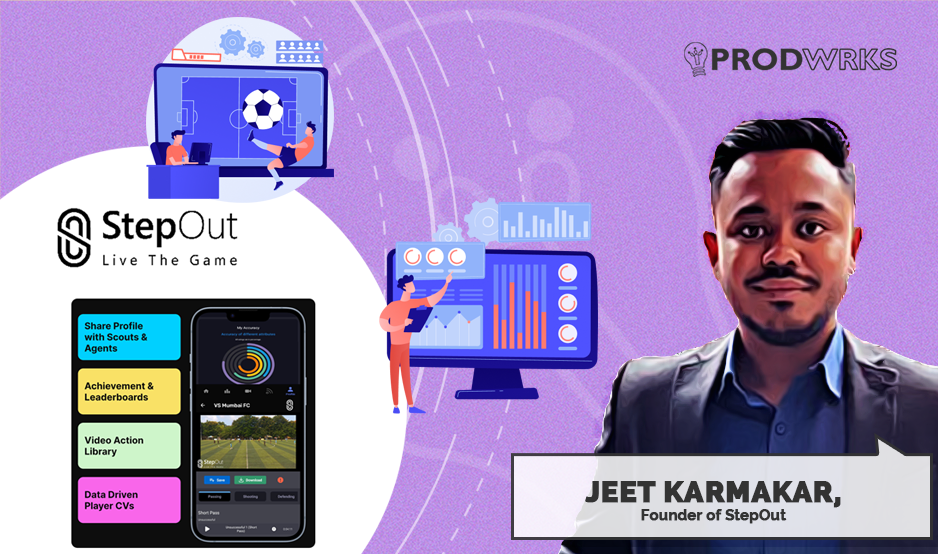
In the football-mad lanes of Kolkata, a young Jeet Karmakar would watch the FIFA World Cup with a mix of passion and patriotic frustration. The streets would be a sea of Brazilian yellow and Argentinian blue, but one flag was always missing, the Indian tricolour. Like millions of our countrymen, he’d join the chorus of disappointment, “Kab khelenge hum?” (when will we play?).
It’s a familiar refrain in a nation of 1.4 billion people that perennially punches below its weight in global sports, especially the world’s most popular one. While most of us stop at snide remarks and complaints about “the system”, Jeet Karmakar and Sayak Ghosh, now the founders of StepOut, decided to move from the side-lines of cynicism to the front lines of innovation, to answer why India isn’t succeeding and to provide the very tools for changing the narrative.
Their bold venture, StepOut, is a sports performance analysis platform that is quietly revolutionizing how football is coached, played, and scouted, from the grassroots level in India to the elite youth academies of Europe. By turning a simple football match video feed into a treasure trove of actionable insights via visualized data, StepOut is democratizing a level of analysis once reserved for the multi-million-dollar budgets of Champions League clubs.
In July 2024, StepOut raised $500,000 funding in seed round led by Rainmatter, the influential investment fund from Zerodha founders Nithin and Nikhil Kamath. But for product leaders, the real story isn’t just the funding.
StepOut’s story is about how Jeet and his team turned a common complaint into a globally competitive, data-driven solution used by local leagues to international clubs like AFC Ajax in Amsterdam. It’s a masterclass in product development, market validation, and building an ecosystem where none existed before.
The Problem: A Sport Without a Report Card
"We used to see stats, scout players, and trade them. The video game provided a granular analysis of every event in a football match from passes to tackles and goals. It was so simple. And then we were wondering why this is not there in real life."

While performance analytics existed at the highest echelons of professional football, with 22-camera setups and teams of data scientists, the grassroots and youth levels (the very foundation of the sport) were operating in a data black hole. Here, the only feedback was a coach’s subjective opinion.
Karmakar draws a powerful analogy that will resonate with any product leader obsessed with metrics.
“In academics I can understand if I'm good or bad in a particular subject because of the marks that I'm getting. If I get 90 marks in maths, it means I'm very good. A 30 in physics means I’m bad in physics. But in sports there was no evaluation happening. It’s only the coach's observations, ‘thu acha khel raha hei’ (you are playing well), but there is no something in between. There is no Analytics layer to measure, track, and then inform them.”
“We would have seen a lot of our own friends getting into corporate jobs and they always used to say that if I had played, I would have had a different life. This sentiment of ‘what if’ became fuel for StepOut.”
Before AI and Code, StepOut’s MVP Was Pen & Paper
“To be very crude, we collected the sports data from a local match on pen and paper. No AI, nothing. That was our Minimum Viable Product (MVP)?,” Karmakar admits with a laugh.
"Whatever data we collect has to be in the lowest common factor," Jeet stresses. "Let's say there's a pass happening, we collect who is making the pass, at what time frame, at what position on the ground, to whom the pass is being made. Each and every information regarding an event is logged."
Once this granular, hand-collected data was available, they wrote simple HTML and JavaScript code to generate a few basic charts and graphs, printed them out, and handed the reports to the teams and players.
This wasn’t a scalable solution, but it didn’t need to be. It was a test. Did the coaches find this valuable? Did the players understand it? The answer was a resounding yes. This primitive MVP proved that there was a hunger for this kind of insight. It validated the problem before a single complex algorithm was written.
This manual process also served as the training data for their future AI. They were building their domain knowledge from the ground up, understanding the nuances of what to track and how to structure it. This early, manual grind was the foundation upon which StepOut’s automated empire would be built.
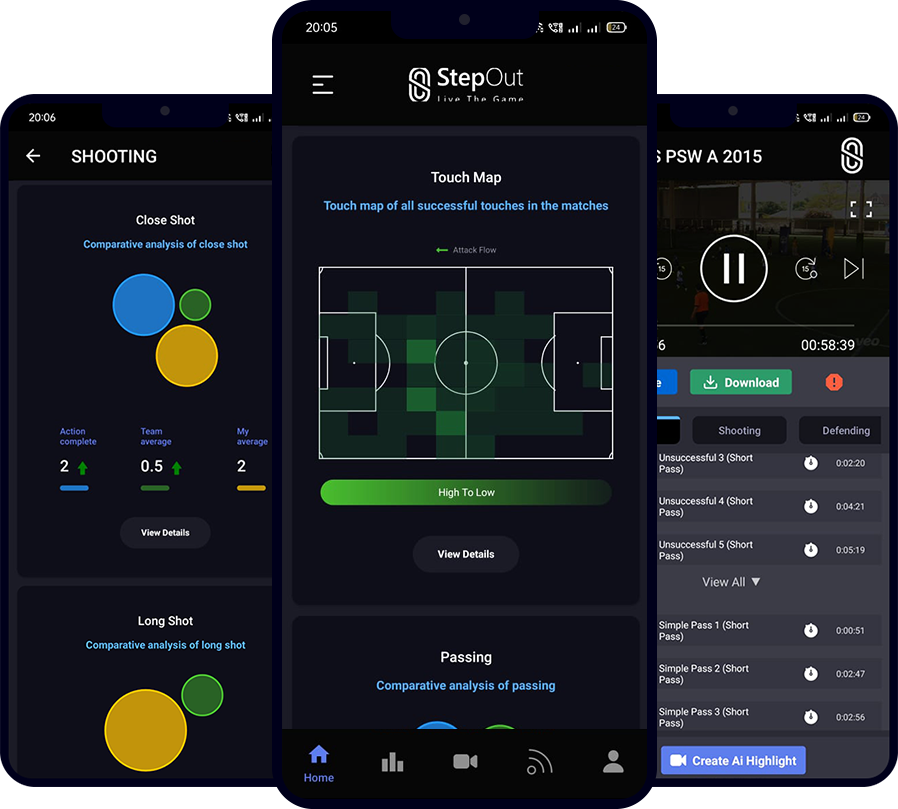
Gamification and Information Design
1. For Coaches and Analysts
"The existing sports analysis solutions out there were too data-driven. Competitors provided raw data in overwhelming Excel sheets that required data science know-how to interpret. It was too complicated for non-tech coaches, some of whom weren’t even accustomed to Excel sheets," Karmakar explains.
StepOut’s response was to invest heavily in information design. The goal was to create visualizations so intuitive that insights would be immediately apparent “just by looking” at the visualizations and data interpretations
Their platform features heatmaps, network analysis showing passing connections, and vector fields illustrating team movement. Crucially, every data point is linked to the corresponding video clip. A coach can see a stat, click on it, and instantly watch the exact moment it happened (a pass, a goal, or a tackle), creating a powerful, context-rich feedback loop.
2. For the Players
"We kind of wanted to not bombard them with a lot of data. We wanted to gamify the experience. We wanted to make sure there are achievements, there are badges, there are all those kinds of leaderboards so that it does not feel like players are seeing their report card, but it feels that they're tracking their progress. Like playing FIFA in real life with themselves and their friends."
The Tech Beneath the Hood - AI, Audits, and Joysticks
The magic of StepOut lies in its ability to extract rich, accurate data from a single video feed, be it from a professional multi-camera broadcast or a match recording on an iPhone. The process is a blend of automation and human oversight.
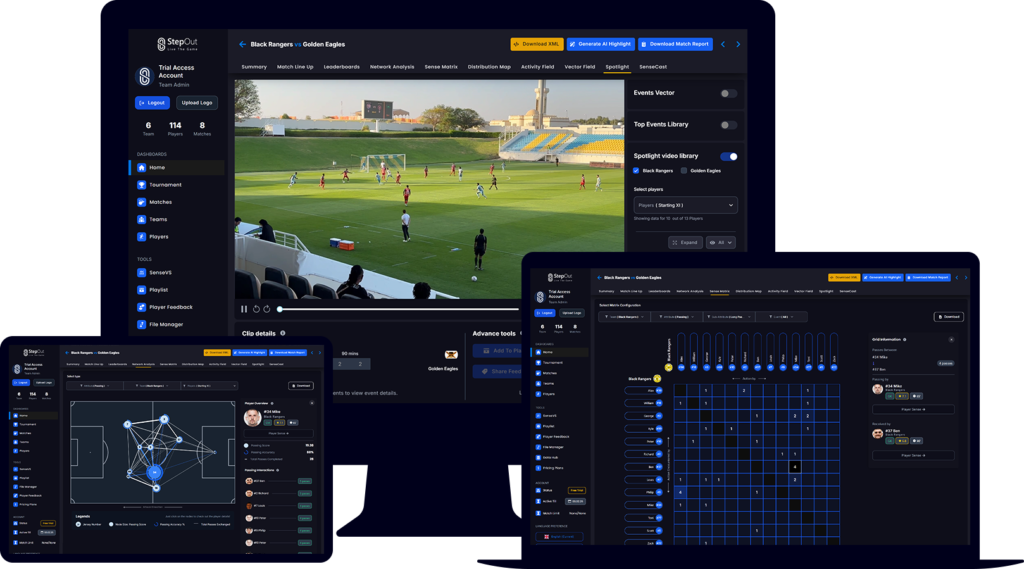
First, their AI models, trained in-house, perform the heavy lifting. They use computer vision to detect players, track their movements, and identify events on the pitch. But Jeet is a pragmatist. He knows AI isn’t infallible.
“Automation is not always 100% accurate. Let's say 2 or 3 or 4 players are coming together for an interception. The AI may sometimes not identify the players accurately when they cross paths. There is an occlusion."
In computer vision, occlusion refers to the situation where parts of a 3D scene are hidden or obscured from view by other objects in the scene. This can happen when objects are partially or completely blocked, creating challenges for tasks like object recognition and tracking.
In specific instances where there are occlusions (when players or referees block the view in a video), StepOut fulfills its commitment to a 99%+ accuracy with a manual intervention. When the AI raises a flag for occlusion, the event is passed to a manual auditing system where analysts can manually tag the right players for the system to function correctly.
But even this internal manual process is a lesson in product innovation. To make the auditing process faster and more intuitive, Jeet’s team has gamified it for their own analysts.
"The mobile turns into sort of a game pad. While the match video plays on a laptop or any screen, both are interconnected. The analyst uses the phone like a joystick to tag events and correct errors, just like playing a game, which they are accustomed to with hours of Fifa gameplay experience!”
Cracking Go-to-Market in SportsTech
"Initially, people used to question, 'Does India even play football?' Even the Indian clubs we reached out to were hesitant to go ahead with an Indian company. They believed that Western tech solutions were more credible as we lacked the experience."
So, building credibility was their biggest hurdle. All that Jeet’s team wanted at this point was a chance to get in front of a potential client. They were confident in their product, knowing from early tests that if they could secure a demo, they would secure the client.
The turning point, the event that shattered the credibility barrier, came from an unexpected source. StepOut entered and won the Reimagine Football Innovation contest, hosted by UEFA and the legendary Dutch club AFC Ajax.
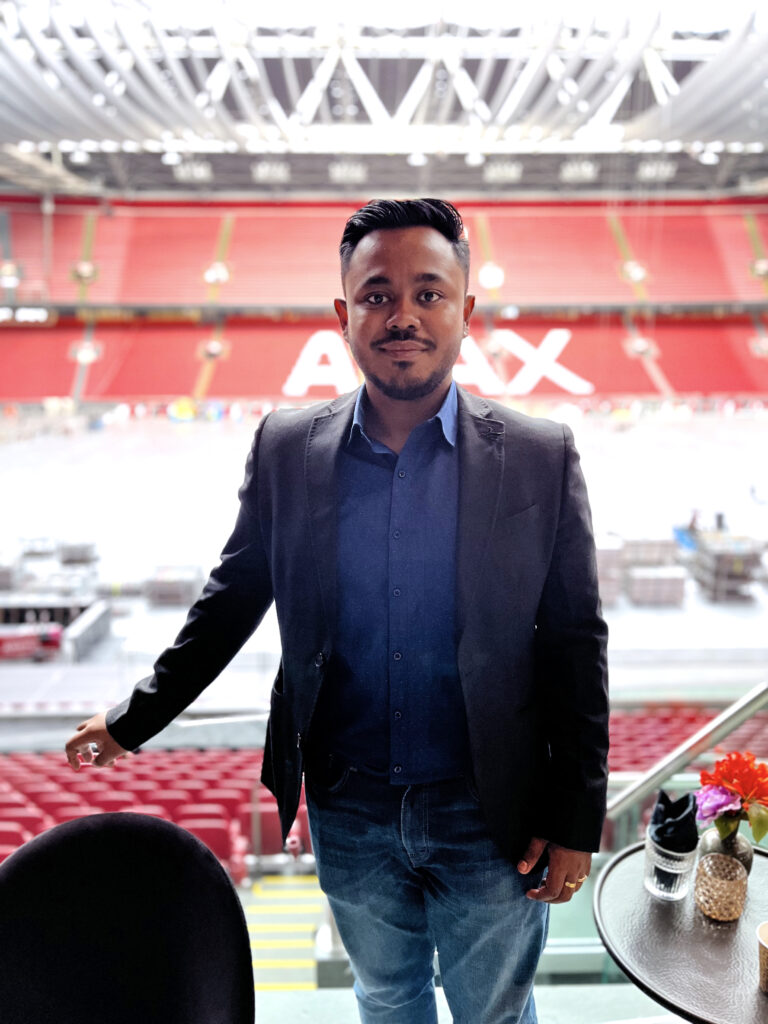
"AFC Ajax found us. They were pretty impressed. And they now use our platform," Jeet says proudly.
This wasn’t just any endorsement. “Ajax are the epitome of youth development in the entire world. They have produced some of the finest talents, from Johan Cruyff to a lot of other Dutch players.”
Suddenly, the conversation changed. Being partnered with Ajax was the ultimate seal of approval. The doors flew open. Cold emails got responses. They landed clients in Canada, the US, Dubai, and across Europe. Today, StepOut is present in 18 countries, working with LaLiga youth academies like Rayo Vallecano, piloting with giants like FC Barcelona and Atletico Madrid, and partnered with entire state associations in Australia and India.
The kid from Calcutta who complained about his country’s football was now providing the analytical backbone to the world’s most revered talent factory.
StepOut’s Two-Pronged Business Model for US and Europe Markets
StepOut’s monetization strategy is as well-thought-out as its product, demonstrating a keen understanding of global sports and its market dynamics. They operate on two distinct models:
1. The European Model (B2B):
2. The US/Australia Model (B2B2C):
In markets like the US, Australia, and to some extent India, youth sports operate on a “pay-to-play” model. Parents pay thousands of dollars a year for their children to be part of an academy. Here, StepOut uses a B2B2C approach.
They charge the academy a per-player fee (e.g., $150/year). The academy simply rolls this into their annual tuition, often ranging around $5,000 – $10,000.
Jeet explains, “For instance, they increase the price from $5000 to $5150 or sometimes a little bit more, which is not even a 3% increase. The academies create an additional revenue stream, get the technology at no cost, and the parents get a full digital record of their child's development. It's a win-win-win.”
“A user sitting in the US behaves differently from a user in Thailand. An academy in Bangalore behaves differently than an academy in Manipur. You have to think about each target market differently. If you are trying to build for every one of them, you will end up in the middle. That's what we learned the hard way. You have to be very careful of whom you are building for, and then you build for them only.”
This strategic monetization by understanding customer segments is reflected in StepOut’s impressive growth. Their revenue grew 4x in the last two financial years. Their target for the next two years is to reach an Annual Recurring Revenue (ARR) of $1 million (approx. ₹8 crores).
For a B2B SaaS company, however, the most important metric is retention. “We have an 85% and above renewal rate, with 100% revenue retention and a 20% year-on-year increase in deal value,” Jeet asserts.
“We got one team at first from an academy. By providing great customer experience and support, we got three teams. Then we got ten. We have a potential of getting into all 42 teams in that academy. Deepening relationships with existing clients is a powerful growth engine.”
AI Coaches and The Future of SportsTech
"It's basically ChatGPT on steroids, having all your (player’s) information. A player will be able to chat with the agent, ask questions about their performance, and receive personalized tactical analysis. It’s a virtual coach available 24/7.”
While football remains the focus, StepOuts’s core technology is sport-agnostic. Expansion into similar field sports like hockey and basketball is on the long-term roadmap.
From a hostel room in Durgapur to the boardrooms of Europe’s top football clubs, StepOut’s journey is a testament to the power of a deeply understood problem, a fanatical focus on user experience, and a willingness to build from the ground up. By asking why India wasn’t on the world’s biggest sporting stage in football, Jeet is now building the very technology that might just help put it there, one data point, one player, one gamified badge at a time.
He is no longer just a “complainer”. He is one of the builders. And for founders everywhere, that is the most inspiring play of all.


